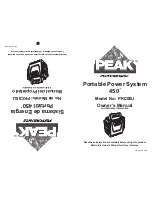
Product Overview
BasicCharge Intelligent EV Charging Pedestal
EVBM-V01-R1 Installation and Operation Manual
Page
7
of
36
December 2022
NOTE:
Where a Rolec Load Balancing Current Transformer (CT) has been installed and
connected to a load balancing enabled Rolec chargepoint, it will reduce the supply of
power to the vehicle where the combined demand of the property and vehicle would
exceed the power available to the property as a whole.
x
Only 1 chargepoint is to be installed per phase to avoid counteracting behaviour.
x
Rolec cannot be held responsible for overloads of the supply caused by other
connected electrical items or failure of the vehicle to accept a reduced rate of
charge.
NOTES:
1. Load balancing ONLY controls power made available to the VEHICLE. It does not
control power to other equipment and it is still possible for that equipment to
overload the property’s power supply.
2. Depending on the manufacturer, electric vehicles need a minimum of around
6 Amps to charge. If the available power is below this level, the vehicle may stop
the charge session.
3. The lower the power available for charging, the more slowly the vehicle will be
charged.
About Load Management
This chargepoint is capable of
Load Management
. This is similar to load balancing in that
the power made available for charging can be dynamically adjusted to decrease or
increase the power available in response to other demands for power at the property.
The significant differences are that Load Management is:
x
controlled by the software application used either within the chargepoint or via its
online connection (or a third-party device/system).
x
more often used where there are several chargepoints at the property, and where,
depending on pre-set criteria within the software, the system will control which
chargepoints receive the most power at any given point in time.
About Demand Side Response
Similar in some ways to Load Management, a
Demand Side Response
(DSR) system is
where the chargepoint and the electricity provider are in communication with each
other. The electricity provider will control the chargepoint remotely via the chargepoint
software to reduce the power it draws when it is needed by higher priorities in the area
and will increase power when those priorities reduce.
If the chargepoint is used with a DSR agreement in place, peak and off-peak charging will
not be implemented because the power company’s systems will control the charging
process.
Although the power drawn (and delivered) by the chargepoint can vary, this does not
necessarily protect the property power supply from being overloaded if the demand of
the property and vehicle exceed the power available to the property as a whole.









































